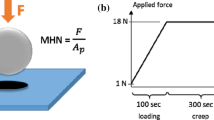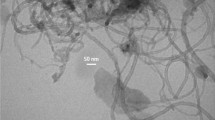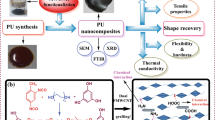Abstract
Carbon nanostructures have been effectively used to reinforce polymers due to their excellent mechanical properties. This paper investigates the thermal and mechanical properties of ultra-high-molecular weight polyethylene UHMWPE nanocomposites reinforced with acid-modified multi-walled carbon nanotubes (MWCNT) and graphite. The UHMWPE nanocomposites were prepared by melt mixing at 200 °C. The test specimens were compression moulded at 215 °C and 7.36 MPa and mechanical and thermal properties were studied with respect to nanofiller content. Evaluation of mechanical and thermal properties of the nanocomposites showed that the addition of up to 1% MWCNT to the UHMWPE significantly improved the tensile and flexural properties by 30%. In the case of graphite, tensile properties decreased while flexural property increased. While the thermal properties such as specific enthalpy and percentage of crystallinity increased with nanofiller content. These observed results are attributed to the nanofiller content as well as the dispersion of the nanofiller in the polymer, which was substantiated by morphological analysis using transmission electron microscopy. However, at higher concentration of carbon nanofillers, both mechanical and thermal properties showed a slight decline due to the formation of agglomerates.
Access provided by Autonomous University of Puebla. Download conference paper PDF
Similar content being viewed by others
Keywords
1 Introduction
Polymer nanocomposites have a wide range of applications and advantages over conventional polymers and composites [1]. The properties of polymer nanocomposites can be tailored by altering the ratio of the polymer matrix and reinforcing elements as well as size, shape and type of nanoreinforcements [2, 3]. Ultra-high-molecular weight polyethylene (UHMWPE) is a semi-crystalline polymer having unique properties like very low coefficient of friction, low wear, high toughness, high impact resistance, low dielectric constant and high thermal conductivity that makes it suitable for a variety of applications like bearings, gears, liners, wear strips, fixtures, armour and radar domes, joint prosthesis, etc. [4, 5]. These applications require mechanical strength in addition to specific properties. The mechanical properties can be improved by either altering the polymer structure like crystallinity and cross-linking or by reinforcing the polymer with fillers [6]. Nanosized fillers are attractive options for reinforcement as they provide the large specific surface area necessary for polymer–filler interactions that tremendously improve polymer properties at filler contents much lower than conventional micro fillers. Carbon-based nanofillers like carbon nanotubes and graphite have unique properties. Carbon nanotubes (CNTs) have exceptional properties like very high tensile strength, stiffness, electrical conductivity, flexibility, elasticity and thermal conductivity, large aspect ratio and low thermal expansion coefficient making them a promising reinforcement for composites [7]. In modern engineering, both single-walled (SWCNT) and multi-walled (MWCNT) are used reinforcement in polymer composites [8, 9]. Most of the research is available UHMWPE–CNT nanocomposites focus on the tribological properties prepared by ball milling technique [10]. Graphite is a crystalline allotrope of carbon having layered arrangement of thick sheets of carbon. Its layered structure providing high surface area, aspect ratio and specific strength make graphite nanoparticles a potential reinforcement for high-strength composites [11]. Generally, carbon nanomaterials have a tendency to agglomerate in a polymer matrix and the properties of nanocomposites depends on how well the nanotubes are dispersed in the polymer [12].
Arash Golchin et al. carried out an investigation of the tribological behaviour of UHMWPE reinforced with multi-walled carbon nanotube and graphene oxide (GO) in water-lubricated sliding contacts. It is found that irrespective of the treatment, GO/MWCNT reinforced composites invariably showed lower friction and higher wear resistance in comparison to the unfilled UHMWPE. This was mainly attributed to the lubricating action of the carbonaceous nanofillers in water-lubricated contacts [13]. Silvia Suñer et al. studied the wear rate, size and volume distributions, bioactivity and biocompatibility of the wear debris generated from UHMWPE/Multi-walled carbon nanotube (MWCNT) nanocomposites for total joint replacement. The studies showed that the addition of MWCNTs led to a significant reduction in wear rate and wear particles from the UHMWPE/MWCNT nanocomposite had lower osteolytic potential compared to those produced from the conventional polyethylene [14]. Investigations on nanotribological behaviour of UHMWPE with graphene nanoplatelet (GNP) reinforcement showed that as GNP content increased, the coefficient of friction decreased while wear resistance decreased by more than four times [15]. A. Bhattacharyya et al. made a detailed study of the improved tensile strength and creep resistance properties UHMWPE reinforced with graphene [16].
This paper investigates the morphological, thermal and mechanical properties of UHMWPE nanocomposites reinforced with acid-modified multi-walled carbon nanotubes and graphite nanocomposites prepared by melt compounding.
2 Experimental
2.1 Materials and Preparations
The UHMWPE used in the work was in powder form, with a molecular weight of 2–6 million amu [HIDEN, YUHWA Korea Petrochemical Ind. Co. Ltd.]. Carbon nanotube used as reinforcement was acid (-COOH) modified MWCNT with length 1–10 micron, outer diameter 5–10 nm and surface area 330 m2/g [United Nanotech Innovations, Bangalore, India]. Graphite (Nano 27) having 99% carbon, surface area 250 m2/g and lamella thickness index 10–11 was sourced from Asbury carbons, Asbury, USA.
UHMWPE–MWCNT/Graphite nanocomposites were prepared by melt mixing in a two roll mill at 200 °C at 40–50 rpm with varying weight percentages of MWCNT/Graphite (0, 0.5, 1 and 1.5%). The nanocomposite test specimens were compression moulded at 215 °C and 7.36 MPa.
2.2 Characterization
The tensile properties were evaluated as per ASTM D638 on INSTRON 4502Universal Testing Machine (UTM) at a crosshead speed of 1 mm/min. The flexural strength and modulus were evaluated on a 3 point UTM with a crosshead speed of 1.25 mm/min as per ASTM D790. The average value obtained for 5 specimens are reported. Differential scanning calorimetry was done on DSC Q20 V24.10 Build 122 in a nitrogen atmosphere at 10 °C/min in the temperature range −100–200 °C. Transmission electron micrographs of the nanocomposites were obtained from Jeol/JEM 2100 transmission electron microscope.
3 Results and Discussion
3.1 Morphology
The dispersion of MWCNT and nanographite in UHMWPE was analysed with transmission electron microscope. From the TEM images in Fig. 1, it was observed that both MWCNT and graphite were well dispersed/exfoliated in at nanofiller content of 0.5 and 1 wt%. In nanocomposites containing 1.5 wt% CNT/Graphite, dispersion as well as agglomeration was observed. One of the reasons for formation of agglomerates is the van der waals force between the CNT particles. At higher nanofiller content the interparticle distance is less and the van der waals force is greater causing agglomeration [17].
3.2 Mechanical Properties
The mechanical properties of UHMWPE nanocomposites are presented in Figs. 2 and 3. In CNT-reinforced UHMWPE, the tensile strength and modulus increased with increasing CNT content. The mechanical properties of the nanocomposite depend on dispersion state of the nanofiller in polymer matrix and the interfacial bonds. As evident from the TEM micrographs in Fig. 1b and d MWCNT was evenly dispersed in UHMWPE. The uniform dispersion of MWCNT and the resulting polymer–filler interfaces and interfacial interactions ensure efficient transfer of mechanical load/stress applied to the MWCNT–UHMWPE interface. The distribution of MWCNT efficiently hindered the chain movements during deformation resulting in improved tensile modulus. At 1.5%, as evident from the TEM images, slight agglomeration caused the interfacial area and interfacial interactions to decrease. The agglomerates of MWCNT also act as macro-particle like centres of friction and stress concentration. Hence, at 1.5% MWCNT, there was slight reduction in mechanical properties.
The tensile strength of UHMWPE decreased marginally with the addition of graphite with a 5.7% decline for 1.5% of graphite. In several polymers, reduction in tensile properties with addition of graphite filler has been attributed to its restrictive effect and deformation of molecular chains [18].
Flexural modulus was calculated by the following equation:
where F = load applied on the middle of the beam
L = distance between the two outer supports
w = width of the beam
d = deflection due to the load
h = height of the beam
Flexural strength of UHMWPE was found to be 11.54 MPa. Figure 3 shows the flexural strength of UHMWPE increases with the addition of MWCNT/Graphite. The content of MWCNTs (0.5–1.5 wt%) enhances and increase the flexural strength from (11.54 MPa for the UHMWPE to 16.45 MPa). Addition of 1.5 wt% of MWCNT leads to increase the flexural strength by 42.54% compared with the UHMWPE and 20% increase by Graphite. Addition of carbon nanofillers creates attractive polar forces and van der Waals bonding between polymer chains. Hence it will increase the constraints between filler/UHMWPE chains and polymer chains itself. The nanofillers attributes a restrictive effect over the UHMWPE by deformation of their molecular chains and restricting the motion [19].
3.3 Thermal Properties
DSC gives us the results of melting, crystallization temperatures, specific enthalpies and degree of crystallinity. These results are tabulated in Table 1:
The percentage of crystallinity was calculated using the following equation:
where ΔHm and ΔHc are the specific enthalpy of melting and re-crystallization.
ΔHm° = Reference value represents heat of melting if the polymer was 100% crystalline.
ΔHm° for UHMWPE was taken as 293.6.
Table 1 shows that there is no change in both melting and crystallization temperatures in all compositions. In polymers, melting point is dependent on the structure of the polymer, primary and secondary bonding between chains, molecular weight, heat and entropy of fusion, etc., by addition of MWCNT there is no appreciable change in the above factors and hence, there is no change in melting point [20]. The specific enthalpies of both melting and recrystallization increased up to 1 wt% of filler content, after which they decreased. The percentage crystallinity of the composites were calculated and plotted as a function of nanofiller content in Fig. 4. There was an increment of 212 and 108% in the degree of crystallinity with 1 wt% of MWCNT and graphite. Upon further increasing the composition of CNT/Graphite degree of crystallinity decreased. It may be concluded that the well-dispersed MWCNT/Graphite induces nucleation sites for crystallization [21]. The increase in crystallinity at 1 wt% of CNT may also contribute to the increase in tensile strength as observed in Fig. 2.
4 Conclusions
Nanocomposites of UHMWPE were prepared by melt mixing with MWCNT and nanoscale graphite as reinforcements. TEM results showed well dispersed MWCNT/Graphite at lower concentrations and agglomeration at 1.5 wt%. The tensile strength of UHMWPE is increased by 14% with 1 wt% of CNT which is attributed to the dispersion of CNT in the matrix as well as increase in percentage crystallization. Beyond this composition, the tensile strength decreased. Young’s modulus increased continuously upon increasing the weight percentage of CNT. Tensile properties of the UHMWPE decreased continuously with the graphite content. Flexural strength of the nanocomposite improved with the addition of CNT/Graphite nanofillers. The addition of CNT/Graphite up to 1% to the UHMWPE significantly improved thermal properties such as specific enthalpy and percentage of crystallinity while the melting point was unaffected. At higher concentration of fillers, both mechanical and thermal properties showed slight decline due to the formation of agglomerates. The optimum composition for UHMWPE—MWCNT/Graphite nanocomposites is 1 wt%.
Abbreviations
- U:
-
Unfilled UHMWPE
- UG-0.5:
-
UHMWPE with 0.5 wt% of graphite
- UG-1:
-
UHMWPE with 1 wt% of graphite
- UG-1.5:
-
UHMWPE with 1.5 wt% of graphite
- UC-0.5:
-
UHMWPE with 0.5 wt% of carbon nanotube
- UC-1:
-
UHMWPE with 1 wt% of carbon nanotube
- UC-1.5:
-
UHMWPE with 1.5 wt% of carbon nanotube
References
M. Remanan, R.S. Rao, S. Bhowmik, L. Varshney, M. Abraham, K. Jayanarayanan, Hybrid nanocomposites based on poly aryl ether ketone, boron carbide and multi walled carbon nanotubes: Evaluation of tensile, dynamic mechanical and thermal degradation properties. E-Polymers 16(6), 493–503 (2016)
N. Ashok, M. Balachandran, F. Lawrence, N. Sebastian, EPDM–chlorobutyl rubber blends in c-radiation and hydrocarbon environment: mechanical, transport, and ageing behavior 45195, 1–11 (2017)
M. Kumar, S. Bhowmik, M. Balachandran, M. Abraham, Composites: part A effect of surface functionalization on mechanical properties and decomposition kinetics of high performance polyetherimide/MWCNT nano composites. Compos. Part A 90, 147–160 (2016)
M. Deng, S.W. Shalaby, Properties of self-reinforced ultra-high-molecular-weight polyethylene composites. Biomaterials 18(9), 645–655 (1997)
J.A. Puértolas, UHMWPE matrix composites, 3rd edn. (Elsevier Inc., Amsterdam, 2016)
A.V. Maksimkin et al., Bulk oriented nanocomposites of ultrahigh molecular weight polyethylene reinforced with fluorinated multiwalled carbon nanotubes with nanofibrillar structure. Compos. Part B Eng. 94, 292–298 (2016)
B.P. Grady, Effects of carbon nanotubes on polymer physics. J. Polym. Sci., Part B: Polym. Phys. 50(9), 591–623 (2012)
B.J. Kim, J.H. Byun, S.J. Park, Effects of graphenes/CNTs co-reinforcement on electrical and mechanical properties of HDPE matrix nanocomposites. Bull. Korean Chem. Soc. 31(8), 2261–2264 (2010)
D.C. Davis, J.W. Wilkerson, J. Zhu, D.O.O. Ayewah, Improvements in mechanical properties of a carbon fiber epoxy composite using nanotube science and technology. Compos. Struct. 92(11), 2653–2662 (2010)
Y. Xue, W. Wu, O. Jacobs, B. Schädel, Tribological behaviour of UHMWPE/HDPE blends reinforced with multi-wall carbon nanotubes. Polym. Test. 25(2), 221–229 (2006)
A. Avanzini, G. Donzella, D. Gallina, Fatigue damage modelling of PEEK short fibre composites. Procedia Eng. 10, 2052–2057 (2011)
T. McNally et al., Polyethylene multiwalled carbon nanotube composites. Polymer (Guildf) 46(19 Special Issue), 8222–8232 (2005)
A. Golchin, A. Wikner, N. Emami, An investigation into tribological behaviour of multi-walled carbon nanotube/graphene oxide reinforced UHMWPE in water lubricated contacts. Tribol. Int. 95, 156–161 (2016)
S. Suñer, C.L. Bladen, N. Gowland, J.L. Tipper, Investigation of wear and wear particles from a UHMWPE/multi-walled carbon nanotube nanocomposite for total joint replacements. Wear 317(1–2), 163–169 (2014)
D. Lahiri, F. Hec, M. Thiesse, A. Durygin, Tribology international nanotribological behavior of graphene nanoplatelet reinforced ultra high molecular weight polyethylene composites. Tribiol. Int. 70, 165–169 (2014)
A. Bhattacharyya, S. Chen, M. Zhu, Graphene reinforced ultra high molecular weight polyethylene with improved tensile strength and creep resistance properties. Express Polym. Lett. 8(2), 74–84 (2014)
Y.-S. Zoo et al., Effect of carbon nanotube addition on tribological behavior of UHMWPE. Tribol. Lett. 16(4), 305–309 (2004)
M.D.S. Hajar et al., Effect of graphite loading on the electrical and mechanical properties of Poly (Ethylene Oxide)/Poly (Vinyl Chloride) polymer films. J. Phys. Conf. Ser. 908(1) (2017). IOP Publishing
Fan-Long Jin, Soo-Jin Park, A review of the preparation and properties of carbon nanotubes-reinforced polymer composites. Carbon Lett. 12(2), 57–69 (2011)
J.A. Brydson, Plastics Materials (Elsevier, Amsterdam, 1999)
J.-F. Gao et al., Temperature-resistivity behaviour of CNTs/UHMWPE composites with a two-dimensional conductive network. Polym. Plast. Technol. Eng. 48(4), 478–481 (2009)
Acknowledgements
We would like to acknowledge the support of Ministry of Human Resources Development (MHRD) extended to CoE-AMGT, Amrita University through their fast grant, CBPST, Kochi, India and STIC, Kochi, India for the conduct of this research.
Author information
Authors and Affiliations
Corresponding author
Editor information
Editors and Affiliations
Rights and permissions
Copyright information
© 2020 Springer Nature Singapore Pte Ltd.
About this paper
Cite this paper
Sarath Kumar, P., Sai Narendra Reddy, K., Unnikrishnan, D., Balachandran, M. (2020). Performance Enhancement of UHMWPE with Surface Functionalized Multiwalled Carbon Nanotubes/Graphite. In: Prakash, R., Suresh Kumar, R., Nagesha, A., Sasikala, G., Bhaduri, A. (eds) Structural Integrity Assessment. Lecture Notes in Mechanical Engineering. Springer, Singapore. https://doi.org/10.1007/978-981-13-8767-8_19
Download citation
DOI: https://doi.org/10.1007/978-981-13-8767-8_19
Published:
Publisher Name: Springer, Singapore
Print ISBN: 978-981-13-8766-1
Online ISBN: 978-981-13-8767-8
eBook Packages: EngineeringEngineering (R0)








